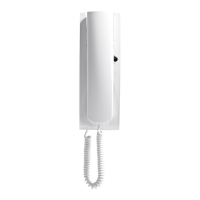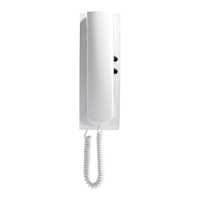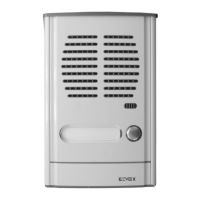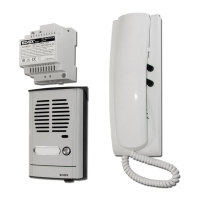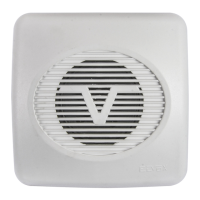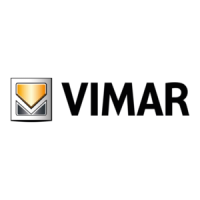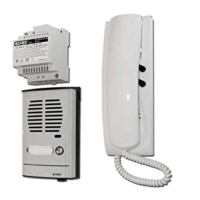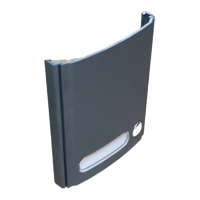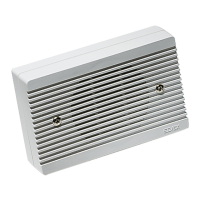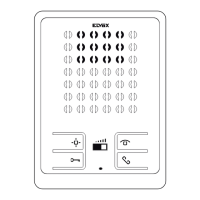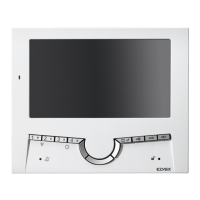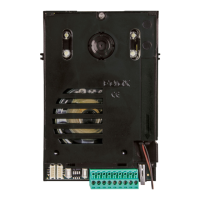Descrption
Type 8879 is an interphone in the 8870 series for Due Fili Plus audio
and video door entry systems. It is supplied as standard with 2 pushbut
-
tons, one for lock release, the other for stair light light (default).
Connection and connector terminal board
1, 2) BUS line.
4, 6P) Connection for door call pushbutton.
5, 6S) Connection of additional door ringtone
Controls
The call volume can be adjusted by moving the loudspeaker wire from
connector A+ (high) to A- (low).
Fig. 1
220 mm
60 mm
75 mm
Programming
There are three interphone programming modes: assignment of an iden-
tication code or call code (indispensable), assignment of a secondary
identication code (for interphones associated with a master interphone),
programming of pushbuttons for auxiliary services and intercommunicating
calls (when necessary).
Programming must be performed with the system switched on, without ac
-
tive communication and only after connecting the interphones/monitors to
the system and programming the panels.
Attention: during the interphone identication code programming you
have 30 seconds from the moment you enter the programming in the
interphone and the moment you press the call push-button on the
panel or you send the code.
Identication code programming
The identication code is programmed via an entrance panel (MASTER),
already congured and present on the system.
The interphone is supplied without associated identication code. To verify
this condition, press the lock release pushbutton and the interphone should
emit a triple “Beep”
Programming phase:
1) Remove the interphone cover.
2) Press and hold the RESET pushbutton on the interphone.
3) Press and hold the tab on the lock release pushbutton, together with the
RESET pushbutton.
4) Release the RESET pushbutton, keeping the lock release pushbutton
pressed.
5) After 2 seconds the interphone emits a high tone and communication is
enabled with the panel.
6) Release the tab of the lock release pushbutton.
7) On pushbutton entrance panels, press the call button for the interphone,
while on alphanumeric keypads, enter the call code and press pushbut
-
ton “ ”.
8) If the system contains an interphone that already has the same associ
-
ated identication code, the panel emits a low signal and the operation
should be repeated from point 2.
9) Otherwise the code is associated with the interphone and communica
-
tion is terminated.
Secondary identication code programming
Programming of the secondary identication code is only required when
more than one interphone is to be called by means of the same pushbutton
or call code. The interphones that ring at the same time are associated with
the same group. The “master” interphone is programmed rst by means of
the “identication code programming” procedure described above, while the
additional group interphones are programmed with the secondary identica
-
tion code (see table page 18).
A maximum of three audio door entry units plus one group master can be
A
A
A
B
Bus termination for video sig-
nal stabilisation
The interphone is provided with a “BUS ter-
mination connector” (A-B-C) for video signal
stabilisation.
Depending on the connection conguration
(interphones/monitors connected in series or
derived from a distributor), set a jumper on
the connector ABC as described in the note
“Bus termination for ELVOX TWO-WIRE
INSTALLATIONS” in the wiring diagrams
section below.
Reset
Attiv.
Video signal
stabiliser
6P6S54
21
A+
A-
CA
Fig. 2
C
B
A
P2
P0
Fig. 3
4
8879
EN
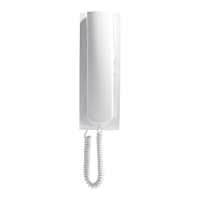
